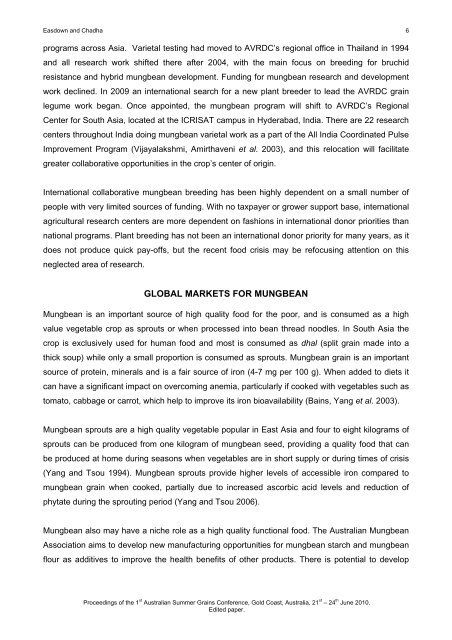4th International Crop Science Congress - Grains Research ...
4th International Crop Science Congress - Grains Research ...
4th International Crop Science Congress - Grains Research ...
Create successful ePaper yourself
Turn your PDF publications into a flip-book with our unique Google optimized e-Paper software.
Easdown and Chadha 6programs across Asia. Varietal testing had moved to AVRDC’s regional office in Thailand in 1994and all research work shifted there after 2004, with the main focus on breeding for bruchidresistance and hybrid mungbean development. Funding for mungbean research and developmentwork declined. In 2009 an international search for a new plant breeder to lead the AVRDC grainlegume work began. Once appointed, the mungbean program will shift to AVRDC’s RegionalCenter for South Asia, located at the ICRISAT campus in Hyderabad, India. There are 22 researchcenters throughout India doing mungbean varietal work as a part of the All India Coordinated PulseImprovement Program (Vijayalakshmi, Amirthaveni et al. 2003), and this relocation will facilitategreater collaborative opportunities in the crop’s center of origin.<strong>International</strong> collaborative mungbean breeding has been highly dependent on a small number ofpeople with very limited sources of funding. With no taxpayer or grower support base, internationalagricultural research centers are more dependent on fashions in international donor priorities thannational programs. Plant breeding has not been an international donor priority for many years, as itdoes not produce quick pay-offs, but the recent food crisis may be refocusing attention on thisneglected area of research.GLOBAL MARKETS FOR MUNGBEANMungbean is an important source of high quality food for the poor, and is consumed as a highvalue vegetable crop as sprouts or when processed into bean thread noodles. In South Asia thecrop is exclusively used for human food and most is consumed as dhal (split grain made into athick soup) while only a small proportion is consumed as sprouts. Mungbean grain is an importantsource of protein, minerals and is a fair source of iron (4-7 mg per 100 g). When added to diets itcan have a significant impact on overcoming anemia, particularly if cooked with vegetables such astomato, cabbage or carrot, which help to improve its iron bioavailability (Bains, Yang et al. 2003).Mungbean sprouts are a high quality vegetable popular in East Asia and four to eight kilograms ofsprouts can be produced from one kilogram of mungbean seed, providing a quality food that canbe produced at home during seasons when vegetables are in short supply or during times of crisis(Yang and Tsou 1994). Mungbean sprouts provide higher levels of accessible iron compared tomungbean grain when cooked, partially due to increased ascorbic acid levels and reduction ofphytate during the sprouting period (Yang and Tsou 2006).Mungbean also may have a niche role as a high quality functional food. The Australian MungbeanAssociation aims to develop new manufacturing opportunities for mungbean starch and mungbeanflour as additives to improve the health benefits of other products. There is potential to developProceedings of the 1 st Australian Summer <strong>Grains</strong> Conference, Gold Coast, Australia, 21 st – 24 th June 2010.Edited paper.
















